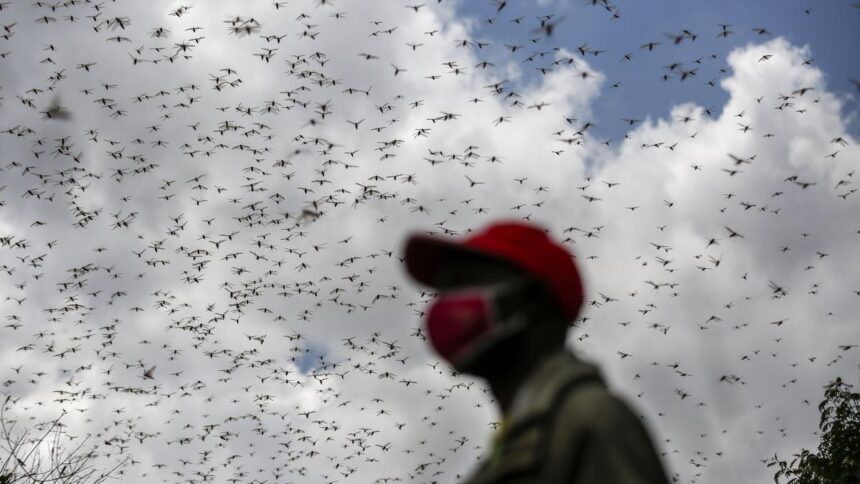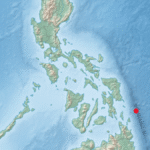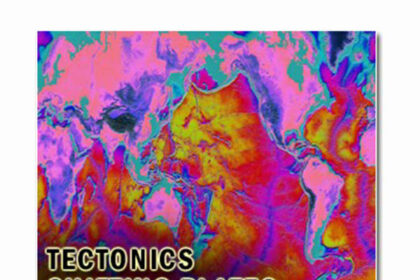A Wave of Desert Locusts Invades Western India
In late 2019, a massive invasion of desert locusts swept through western India and Pakistan. These insects, which originated in the arid plains of East Africa, had already traveled thousands of kilometers before making landfall.
Locusts are grasshoppers that multiply rapidly under favorable conditions. They change color and size in response to their environment. In a process called gregarisation, they transition from solitary creatures to a swarm, congregating in large numbers and traveling together over several leagues at a time.
Historically, these outbreaks have led to widespread famine and economic devastation, earning them the name "locust plagues." The 2019-2022 outbreak was the worst to hit Kenya in 70 years and to hit Ethiopia, Somalia, and India in 25 years. More than 200,000 hectares of crops were destroyed.
At this time, researchers in German and North American universities saw an opportunity to study locust swarms and flew to Kenya, hoping to refine a long-standing theory about swarming behavior.
Previous models of locust swarms treated them like gases in motion. Specifically, they assumed individual locusts aligned with their neighbors like self-propelled particles — a model-object used in theoretical physics.
"Initially, we wanted to replicate what we thought we knew," Iain Couzin, director of the Max Planck Institute of Animal Behavior and professor at the University of Konstanz, who has studied collective intelligence and locust behavior for over two decades, said. "But what we didn’t expect was to find that we could not replicate our previous findings, and that completely changed our understanding of how locusts form these massive swarms."
In a recent paper, Couzin and his team proposed a revised model to make sense of swarms. According to this model, locusts don’t behave like gases. Instead, their movement is based on a cognitive decision-making process based on their perception of nearby motion.
The finding marks a major shift in how scientists understand locust behavior and their ability to make swarm-related predictions. As climate change continues to alter locusts’ breeding patterns, this refined understanding may be the key to protecting crops and livelihoods before the next swarm arrives.
From Field to Holograms
Just before the spread of COVID-19 became a pandemic, some members of the research team (other than Couzin) conducted a study in Kenya’s Samburu and Isiolo counties. They examined large, ground-marching bands of young locusts using precise tracking methods and noticed a pattern. The locusts weren’t explicitly aligning with their immediate neighbors, contrary to what the self-propelled particles model predicted.
To test their observations, they conducted sensory-deprivation experiments in which they altered the insects’ ability to see, smell or sense movement.
The results revealed that vision had a major influence in determining how locusts moved within a swarm. Locusts that couldn’t see clearly lost their sense of direction while those with intact vision moved with the swarm even without physical contact.
"Those data showed that olfaction wasn’t important, tactile cues weren’t important, but vision was really, really important," Couzin said. "That justified the use of holographic virtual reality to study this phenomenon in more detail."
The scientists placed locusts in a fully immersive virtual-reality environment and tested their response to different visual stimuli. In these experiments, the locusts interacted with computer-generated swarms that varied in density and movement order. Soon, their key finding emerged: coherence of motion rather than crowding controlled their alignment.
Even in sparsely populated swarms, the locusts moved together if their visual cues were strong.
The team realized locusts weren’t behaving like gas particles. Instead, their movement followed a decision-making process based on their perception of nearby motion.
To represent this, the researchers developed a new mathematical model based on a neural ring attractor network, a concept in neuroscience. Instead of treating locusts as mindless particles, the approach addressed them as decision-making entities that could integrate multiple visual inputs before choosing a direction.
The model suggested locusts may weigh different potential options and make effective decisions. "However, at the group level, there’s no planning at all," Couzin added. "The group is an emergent phenomenon."
An emergent phenomenon is a complex pattern arising from simple interactions, without central control. In locust swarms, collective movement emerges from each locust’s individual behavior, creating large, coordinated swarms without a leader. This is how flocks of birds and traffic jams work, too.
"This study established how swarms move and how coordinated motion arises," Sercan Sayin, neurologist and molecular biologist at the University of Konstanz and one of the study’s authors, said. "The initial direction selection and how this is maintained — that’s the next question we would like to answer."
‘Wrong Way of Thinking’
Understanding how locusts move has real-world consequences. Yet how these groups emerge or which exact factors determine the direction of their flight remains unclear.
Climate change has worsened the problem by increasing rainfall in desert regions, creating ideal breeding conditions. The 2019-2022 outbreak — one of the worst in decades — was fueled by unusually strong monsoons and cyclones in the Arabian Sea. Cyclones Mekunu and Luban had also struck the Arabian Peninsula in 2018. Unusual monsoons and delayed control worsened the crisis, creating a swarm.
"We thought we had a good understanding, and the old models were being used to try to make predictions, but that was the wrong way of thinking," Couzin said. "Hopefully, now we’ve set the record straight and we can start building a team effort to make increasingly accurate predictions. One way to do that, of course, is to start tracking animals in the wild."
"With the changing climate, the swarms are expected to become larger and more unpredictable, making management more difficult," he added. "To really be able to make predictive models or understand this better, we need much more research. We also need to involve climate scientists and vegetation experts."
Monika Mondal is a freelance science and environment journalist.
Reference : https://www.thehindu.com/sci-tech/science/new-model-finds-locusts-making-complex-decisions-in-deadly-swarms/article69504538.ece








